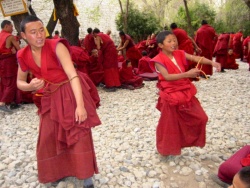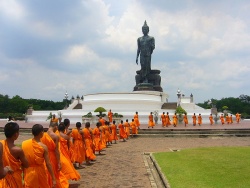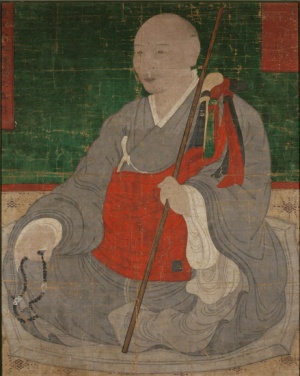Bhikkhu
A Bhikkhu (Pāli) or Bhikṣu (Sanskrit) is an ordained male Buddhist monastic. A female monastic is called a Bhikkhuni (Skt: Bhikṣuṇī) Nepali: भिक्षुणी). The Life of Bhikkhus and Bhikkhunis is
governed by a set of rules called the patimokkha within the Vinaya's framework of monastic discipline. Their lifestyle is shaped to support their spiritual practice, to live a simple and meditative Life, and
attain Nirvana. In the Vinaya monastic discipline, a man under the age of 20 cannot ordain as a bhikkhu but can ordain as a Samanera (เณร); the female counterpart is Samaneri.
Introduction
Bhikkhu may be literally translated as "beggar" or more broadly as "one who lives by alms". It is
philologically analysed in the Pāli commentary of Buddhaghosa as "the person who sees danger (in Samsara
or cycle of Rebirth)" (Pāli: Bhayaṃ ikkhatīti: bhikkhu). He therefore seeks ordination to release from it. The Dhammapada states:
He is not thereby a Bhikkhu
merely because he seeks alms from others;
by following the whole code (of morality)
one certainly becomes a Bhikkhu and not (merely) by seeking alms. Herein he who has transcended both good and Evil,
whose conduct is sublime,
who lives with understanding in this World,
he, indeed, is called a Bhikkhu.
A bhikkhu has taken a vow to enter The Sangha (Buddhist monastic community) and is expected to obey the Patimokkha, rules of monastic conduct (typically around 227 for a male and 311 for a
female) as set out in the Vinaya, although there are considerable local variations in the interpretations of these rules. A novice Monk or nun in the Tibetan tradition takes 36 vows of conduct. The
minimum age to take bhikkhu vows according to ruling is 20 years counted from the conception (i.e., approximately 19 years and 3 months from birth).
In English literature before the mid-20th century, Buddhist Monks were often referred to by the term bonze, particularly when describing Monks from East Asia and French Indochina. This
term is derived via Portuguese and French from the Japanese word bonsō for a priest or Monk and has become less common in modern literature.
Becoming a Bhikkhu/Bhikkhuni
In India, monasticism is part of the system of "vows of individual Liberation". These vows are taken by Monks and nuns from the ordinary Sangha, in order to develop personal ethical discipline.
In Mahayana Buddhism, the term "Sangha" is, in principle, often understood to refer particularly to the Arya Sangha (Tib. mchog kyi tshogs, pronounced chokyi tsok)) the "community of the Noble ones who have reached the first Bhumi". These, however, need not be Monks and nuns.
The vows of individual Liberation are taken in four steps. A lay person may take the five Upāsaka (Pali and Sanskrit; feminine: upāsikā; Tibetan dge snyan/dge snyan ma, pronounced
genyen/genyenma, "approaching Virtue") vows. The next step is to enter the pabbajja (Srt: pravrajya, Tib. rab byung pronounced rabjung), or monastic way of Life, which includes wearing Monk's or nun's
robes. After that, one can become a Samanera (Pali; feminine: Samaneri; Skt. śrāmaṇera/śrāmaṇeri, Tib. dge tshul/dge tshul ma, pronounced getshül/getshülma), or novice
Monk/nun. The last and final step is to take all the vows of a bhikkhu/bhukkhuni (Pali, Sanskrit: Bhikṣu/Bhikṣuṇīs, Tib. dge long/dge long ma>, pronounced Gelong/Gelongma) a "[[fully ordained Monk/nun."
Monks and nuns take their vows for a lifetime. A Monk can give bhikkhu vows back and return to home living, and take the vows again later. He can take them up to three times or seven times in one Life; after
that The Sangha should not accept him. In this way, Buddhism keeps the vows "clean". It is possible to keep them or to leave this lifestyle, but it is considered extremely negative to break these vows.
In Tibet, rabjung, getshül, Gelong ordinations are usually taken at ages six, fourteen and twenty-one or older, respectively.
Robes
- See also: Kasaya
The special dress of ordained people, the robes, comes from the idea of wearing cheap Clothes just to
protect the Body from weather and climate. Monks often make their own robes from cloth that is donated to them. They shall not be made from one piece of cloth, but mended together from several pieces. Since dark red was the cheapest colour in Kashmir, the Tibetan tradition has red robes. In the south,
yellow played the same role, though the color of saffron also had cultural associations in India; in East Asia, robe color varies from yellow to brown (Thailand, Theravada), red to purple (Burma, Theravada) and grey or black (e.g., Vietnam, Vajrayana (Zen)).
The robes of getshül novices and Gelong Monks differ in various aspects, especially in the application of "holes" in the Gelong dress. Some Monks tear their robes into pieces and then mend these pieces together again.
The rabjung novices shall not wear the "(chö-göö", the yellow tissue worn during Buddhist teachings by both getshüls and gelongs.
In observance of the Kathina Puja, a special Kathina robe is made in 24 hours from donations by lay supporters of a temple. The robe is donated to the temple or Monastery, and the resident Monks then select from their own number a single Monk to receive this special robe.
Additional vows in the Mahayana and Vajrayana traditions
In Mahayana traditions, a Bhikṣu may take additional vows not related to ordination, including the Bodhisattva vows, Samaya vows, and others, which are also open to laypersons in most instances.
In addition, in some traditions there are forms of non-Vinaya ordinations, the holders of which are not considered Bhikṣus.
These included ordination into the "White Sangha" lineage of Tibetan yogis (Tib. naljorpa/naljorma, <rnal hbyor pa/ma>), and all of the ordination lineages of the various Japanese traditions.
Conclusion
"Ordination" in Buddhism is a cluster of methods of self-discipline according to the needs, possibilities and capabilities of individuals. According to the spiritual development of his followers, The
Buddha gave different levels of vows. The most advanced method is the state of a Bikshu(ni), a fully ordained follower of The Buddha's teachings. The goal of the Bhikku(ni) in all traditions is to achieve
Liberation from Suffering.
Monks in Japan
Saicho (AKA Dengyo) petitioned for a Mahayana ordination platform to be built in Japan. Permission was granted seven days after Dengyo died. The platform was completed in 827 CE by Dengyo's Disciple, Gishin.
Dengyo believed the 250 precepts were Hinayana, and that people should be ordained with the Mahayana Precepts of the Brahma Net Sutra.
During the Meiji Restoration, monastics in Japan were permitted to marry and eat meat to secularise them and promote the new imperial Shinto as a state religion, Buddhism having been the administrative assistant of choice of the previous regime.
Religious mendicant; Buddhist fully ordained monk. Bhiksuni is the equivalent term designating a woman. A Buddhist monk, a Buddhist nun. Buddhist monk; a man who has given up the householders life to live a life of heightened virtue (see sila) in accordance with the Vinaya in general, and the
Patimokkha rules in particular. See sangha, parisa, upasampada. Bhiksu in Sanskrit, Bhikkhu in Pali. A monk, who has left home, is fully ordained to follow the way of the Buddha, and depends on
alms for a living. Bhiksuni in Sanskrit, Bhikkhuni in Pali. A nun observing more strict rules than a Bhiksu. See also Bhiksu. A religious mendicant; a fully ordained Buddhist monk.
Religious mendicant; Buddhist fully ordained monk. Bhikshuni is the equivalent term designating a woman.
A Bhikkhu, (Sanskrit: Bhiksu) is a fully ordained male Buddhist monastic. Female monastics are called Bhikkhunis (Skt: Bhiksunis). Bhikkhus and Bhikkhunis keep many precepts: they
live by the vinayas framework of monastic discipline, the basic rules of which are called the
patimokkha. Their lifestyle is shaped so as to support their spiritual practice, to live a simple and meditative life, and attain Nirvana.
The Dhammapada states:
Not therefore is he a bhikkhu
Merely because he begs from others.
Not by adopting the outward form
Does one truly become a bhikkhu.
He who wholly subdues evil,
Both small and great,
Is called a monk (bhikkhu)
Because he has overcome all evil. Dhp 266, 267
A Buddhist "monk" ("nun"); a man (woman) who has given up the householders life to live a life of heightened virtue in accordance with the Vinaya in general, and the Patimokkha rules in particular. Techincal
term for mendicant monk, a religious professional who has abandoned worldly pleasures to attain Buddhist idea of nirvana.
(A being who renounces (the pleasures of the world)). The most often, this term refers to Buddhas disciples, to the members of the sangha. To be a bhikkhu, one should give up all worldly possessions except a bowl, a robe and a few utensils such as a razor, a tooth brush, a water filter, etc. One should then perform a specific
ceremony that does unfold according to the rules of the appropriate kammavaca, within a sima, in the presence of at least five bhikkhus, and positively answer fifteen questions.
Basically, this term defines the one who seeks detachment and strives to follow this path (with a shaven head or not). The bhikkhu is someone who abandons all enterprises and everything that can bring some enjoyment, possessions
or fame. He relentlessly trains for liberation and remains vigilant and attentive to everything that appears to his mind. The rest of the time, he studies and teaches the dhamma.
A fully ordained disciple of the Buddha is called a bhikkhu.
"Mendicant monk" may be suggested as the closest equivalent for "Bhikkhu", literally it means "he who begs" but bhikkhus do not beg. They silently stand at the door for alms. They live on what is spontaneously given by the supporters.
He is not a priest as he is no mediator between God and man. He has no vows for life, but he is bound by his rules which he takes of his own accord. He leads a life of voluntary poverty and celibacy. If he is unable to live the Holy Life, he can discard the robe at any time.



